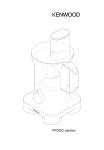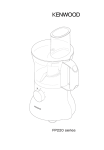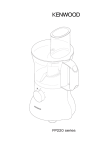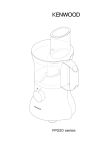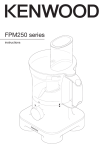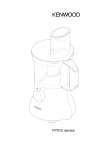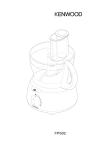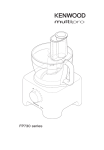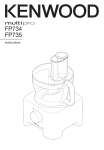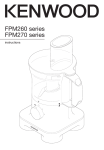Download Kenwood FP260 Series Food Processor User Manual
Transcript
FP260 series + , , a b ● ● Important – UK only before using your Kenwood appliance Read these instructions carefully and retain for future reference. Remove all packaging and any labels. ● safety ● ● ● ● ● ● ● ● ● ● ● ● ● ● ● ● ● ● ● ● The blades and discs are very sharp, handle with care. Always hold the knife blade by the finger grip at the top, away from the cutting edge, both when handling and cleaning. Always remove the knife blade before pouring contents from the bowl. Keep hands and utensils out of the processor bowl and liquidiser goblet whilst connected to the power supply. Switch off and unplug:● before fitting or removing parts; ● when not in use; ● before cleaning. Never use your fingers to push food down the feed tube. Always use the pusher/s supplied. Before removing the lid from the bowl or liquidiser/mill from the power unit:● switch off; ● wait until the attachment/blades have completely stopped; ● be careful not to unscrew the liquidiser goblet or mill jar from the blade assembly. Liquids should be allowed to cool to room temperature before blending. Do not use the lid to operate the processor, always use the on/off speed control. This machine will be damaged and may cause injury if the interlock mechanism is subjected to excessive force. Never use an unauthorised attachment. Never leave the appliance unattended when it is operating. Never use a damaged appliance. Get it checked or repaired: see ‘service and customer care’. Never let the power unit, cord or plug get wet. Don’t let excess cord hang over the edge of a table or worktop or touch hot surfaces. Do not exceed the maximum capacities stated in the recommended speed chart. This appliance is not intended for use by persons (including children) with reduced physical, sensory or mental capabilities, or lack of experience and knowledge, unless they have been given supervision or instruction concerning use of the appliance by a person responsible for their safety. Children should be supervised to ensure that they do not play with the appliance. Only use the appliance for its intended domestic use. Kenwood will not accept any liability if the appliance is subject to improper use, or failure to comply with these instructions. Misuse of your processor/liquidiser can result in injury. ● ● ● ● before using for the first time 1 Remove all packaging including the plastic blade covers from the knife blade. Take care the blades are very sharp. These covers should be discarded as they are to protect the blade during manufacture and transit only. 2 Wash the parts see ‘cleaning’ 3 Push excess cord into the back of the machine. Refer to the relevant section under “using the attachments” for additional safety warnings for each individual attachment. ● The wires in the cord are coloured as follows: Green and Yellow = Earth, Blue = Neutral, Brown = Live. The appliance must be protected by a 13A approved (BS1362) fuse. WARNING: THIS APPLIANCE MUST BE EARTHED. Note: For non-rewireable plugs the fuse cover MUST be refitted when replacing the fuse. If the fuse cover is lost then the plug must not be used until a replacement can be obtained. The correct fuse cover is identified by colour and a replacement may be obtained from your Kenwood Authorised Repairer (see Service). If a non-rewireable plug is cut off it must be DESTROYED IMMEDIATELY. An electric shock hazard may arise if an unwanted non-rewireable pug is inadvertently inserted into a 13A socket outlet. This appliance conforms to EC directive 2004/108/EC on Electromagnetic Compatibility and EC regulation no. 1935/2004 of 27/10/2004 on materials intended for contact with food. before plugging in Make sure your electricity supply is the same as the one shown on the underside of your machine. 2 key ● processor ● pusher feed tube lid bowl detachable drive shaft speed + pulse control power unit safety interlock cord storage to use your liquidiser 1 Fit the sealing ring into the blade unit - ensuring the seal is located correctly. Leaking will occur if the seal is damaged or not fitted correctly. 2 Screw the goblet onto the blade assembly . The liquidiser will not work if incorrectly assembled. 3 Put your ingredients into the jug. 4 Fit the lid to the goblet and push down to secure . Fit the filler cap. 5 Place the liquidiser onto the power unit and turn clockwise to lock . 6 Select a speed or use the pulse control. glass liquidiser blade unit sealing ring goblet lid filler cap ● glass mill ● jar ● attachments ● ● important Your processor bowl is not suitable for crushing or grinding coffee beans, or converting granulated sugar to caster sugar. When adding almond essence or flavouring to mixtures avoid contact with the plastic as this may result in permanent marking. knife blade dough tool twin beater geared whisk thick slicing/coarse shredding disc thin slicing/fine shredding disc rasping disc geared citrus press (if supplied) ● ● ● to use your food processor 1 Fit the detachable shaft onto the power unit . 2 Then fit the bowl. Place the handle towards the back and turn clockwise until it locks . 3 Fit an attachment over the drive shaft. ● Always fit the bowl and attachment onto the machine before adding ingredients. 4 Fit the lid - ensuring the top of the drive shaft locates into the centre of the lid. ● Do not use the lid to operate the processor, always use the on/off speed control. 5 Switch on and select a speed. ● The processor won’t work if the bowl and lid are fitted incorrectly. ● Use the pulse control for short bursts. The pulse will operate as long as the control is held in position. 6 Reverse the above procedure to remove the lid, attachments and bowl. ● Always switch off before removing the lid. ● ● ● ● ● ● ● 3 safety Liquids should be allowed to cool to room temperature before blending. Always take care when handling the blade assembly and avoid touching the cutting edge of the blades when cleaning. Only operate the liquidiser with the lid in place. Only use the goblet with the blade assembly supplied. Never run the liquidiser empty. To ensure the long life of your liquidiser, do not run it for longer than 60 seconds. Smoothie recipes - never blend frozen ingredients that have formed a solid mass during freezing, break it up before adding to the goblet. hints When making mayonnaise, put all the ingredients, except the oil, into the liquidiser. Remove the filler cap. Then, with the appliance running, add the oil slowly through the hole in the lid. Thick mixtures, e.g. pâtés and dips, may need scraping down. If the mixture is difficult to process, add more liquid. Ice crushing - operate the pulse in short bursts until crushed to the desired consistency. The processing of spices is not recommended as they may damage the plastic parts. The appliance will not work if the liquidiser is incorrectly fitted. To blend dry ingredients - cut into pieces, remove the filler cap, then with the appliance running, drop the pieces down one by one. Keep your hand over the opening. For best results empty regularly. Don’t use the liquidiser as a storage container. Keep it empty before and after use. Never blend more than 1.2 litres - less for frothy liquids like milkshakes. to use your mill ● ● Use the mill for milling herbs, nuts and coffee beans. 1 Put the ingredients into the jar . 2 Fit the sealing ring into the blade unit . 3 Turn the blade unit upside down. Lower it into the jar, blades down. 4 Screw the blade unit onto the jar until finger tight . 5 Place the mill onto the power unit and turn clockwise to lock . 6 Switch onto maximum speed or use the pulse control. ● ● ● ● ● ● Never remove the mill until the blades have completely stopped. To ensure the long life of your mill, never run for longer than 30 seconds. Switch off as soon as you have got the right consistency. The processing of spices is not recommended as they may damage the plastic parts. The appliance will not work if the mill is incorrectly fitted. Use for dry ingredients only. hints Herbs are best milled when clean and dry. safety Never fit the blade unit to your food processor without the jar fitted. Never unscrew the jar while the mill is fitted to your appliance. Do not touch the sharp blades – Keep the blade unit away from children. recommended speed chart tool/attachment function speed knife blade Cake making Rubbing fat into flour Adding water to combine pastry ingredients Chopping & pureeing 1–2 2 1–2 2 Thick soup mixes (500mls liquid to 500g dry ingredients) Thinner soup mixes/milk yeasted mixes Egg whites Cream Firm food items such as carrots, hard cheeses Softer items such as cucumbers, tomatoes Parmesan cheese, Potato for German potato dumplings Citrus fruits All processing Herbs Nuts and Coffee Beans 1–2 400g/14oz chopping lean meat total weight 1 litre 1–2 2 2 1–2 2 1 2 600 ml 340g/12oz flour weight 4 250 ml – – – 1 2 2 2 – 1.2 litres 10g 50g dough tool whisk discs - slicing/shredding rasping disc citrus press liquidiser mill 4 maximum capacities 1Kg/2lb 4oz total weight 250g/9oz flour weight using the attachments slicing/shredding discs To use the discs. see chart above for speed of each attachment. reversible slicing/shredding discs - thick , thin Use the shredding side for cheese, carrots, potatoes and foods of a similar texture. Use the slicing side for cheese, carrots, potatoes, cabbage, cucumber, courgette, beetroot and onions. knife blade/ dough tool The knife blade is the most versatile of all the attachments. The length of the processing time will determine the texture achieved. For coarser textures use the pulse control. Use the knife blade for cake and pastry making, chopping raw and cooked meat, vegetables, nuts, pate, dips, pureeing soups and to also make crumbs from biscuits and bread. rasping disc Grates Parmesan cheese and potatoes for German potato dumplings. Use the dough tool for yeasted mixes. ● ● ● ● ● ● safety hints knife blade Cut food such as meat, bread, vegetables into cubes approximately 2cm/3/4in before processing. Biscuits should be broken into pieces and added down the feed tube whilst the machine is running. When making pastry use fat straight from the fridge cut into 2cm/3/4in.cubes. Take care not to over-process. dough tool Place the dry ingredients in the bowl and add the liquid down the feed tube whilst the machine is running. Process until a smooth elastic ball of dough is formed this will take 60 secs. Re-knead by hand only. Re-kneading in the bowl is not recommended as it may cause the processor to become unstable. ● ● to use the cutting discs 1 Fit the drive shaft and bowl onto the power unit. 2 Holding by the centre grip, place the disc onto the drive shaft with the appropriate side uppermost. 3 Fit the lid. 4 Put the food in the feed tube. 5 Switch on and push down evenly with the pusher - never put your fingers in the feed tube. twin beater geared whisk ● Use for light mixtures only eg egg whites, cream, evaporated milk and for whisking eggs and sugar for fatless sponges. Heavier mixtures such as fat and flour will damage it. ● ● using the whisk ● 1 Fit the drive shaft and bowl onto the power unit. 2 Push each beater securely into the drive head. 3 Fit the whisk by carefully turning until it drops over the drive shaft. 4 Add the ingredients. 5 Fit the lid - ensuring the end of the shaft locates into the centre of the lid. 6 Switch on. ● ● ● Never remove the lid until the cutting disc has completely stopped. Handle the cutting discs with care - they are extremely sharp hints Use fresh ingredients Don’t cut food too small. Fill the width of the feed tube fairly full. This prevents the food from slipping sideways during processing. Food placed upright comes out shorter than food placed horizontal. There will always be a small amount of waste on the disc or in the bowl after processing. citrus press (if supplied) Use the citrus press to squeeze the juice from citrus fruits (eg oranges, lemons, limes and grapefruits). cone sieve important The whisk is not suitable for making one-stage cakes or creaming fat and sugar as these mixes will damage it. Always use the knife blade for cake making. to use the citrus press 1 Fit the drive shaft and bowl onto the power unit. 2 Fit the sieve into the bowl - ensuring the sieve handle is locked into position directly over the bowl handle. 3 Place the cone over the drive shaft turning until it drops all the way down. 4 Cut the fruit in half. Then switch on and press the fruit onto the cone. ● The citrus press will not operate if the sieve is not locked correctly. hints Best results are obtained when the eggs are at room temperature. Ensure the bowl and whisks are clean and free from grease before whisking. 5 care & cleaning ● ● ● ● ● Always switch off and unplug before cleaning. Handle the blades and cutting discs with care - they are extremely sharp. Some foods may discolour the plastic. This is perfectly normal and won’t harm the plastic or affect the flavour of your food. Rub with a cloth dipped in vegetable oil to remove the discolouration. IMPORTANT INFORMATION FOR CORRECT DISPOSAL OF THE PRODUCT IN ACCORDANCE WITH EC DIRECTIVE 2002/96/EC. At the end of its working life, the product must not be disposed of as urban waste. It must be taken to a special local authority differentiated waste collection centre or to a dealer providing this service. Disposing of a household appliance separately avoids possible negative consequences for the environment and health deriving from inappropriate disposal and enables the constituent materials to be recovered to obtain significant savings in energy and resources. As a reminder of the need to dispose of household appliances separately, the product is marked with a crossed-out wheeled dustbin. power unit Wipe with a damp cloth, then dry. Ensure that the interlock area is clear of food debris. Store excess cord in the storage area at the back of the machine . liquidiser/mill 1 Empty the goblet/jar before unscrewing it from the blade assembly. 2 Wash the goblet/jar by hand. 3 Remove and wash the sealing ring. 4 Don’t touch the sharp blades – brush them clean using hot soapy water, then rinse thoroughly under the tap. Don’t immerse the blade unit in water. 5 Leave to dry upside down. ● ● twin beater geared whisk Detach the beaters from the drive head by gently pulling them free. Wash in warm soapy water. Wipe the drive head with a damp cloth, then dry. Do not immerse the drive head in water. ● ● ● ● ● ● bowl/lid and attachments Wash by hand, then dry. Alternatively they can be washed on the top rack of your dishwasher. A short low temperature program is recommended. ● ● service and customer care ● If the cord is damaged it must, for safety reasons, be replaced by Kenwood or an authorised Kenwood repairer. UK If you need help with: ● Using your machine ● Servicing or repairs (in or out of guarantee) call Kenwood on 023 92392333 and ask for customer care. Have your model number ready - it’s on the underside of the processor. ● spares and attachments call 0844 557 3653. other countries Contact the shop where you brought the food processor. ● ● Designed and engineered by Kenwood in the UK. Made in China. 6 guarantee UK only If your food processor goes wrong within one year from the date you bought it, we will repair it (or replace it if necessary) free of charge provided: you have not misused, neglected, or damaged it; it has not been modified (unless by Kenwood); it is not second hand; it has not been used commercially; you have not fitted a plug incorrectly; and you supply your receipt to show when you bought it. This guarantee does not affect your statutory rights. recipes shortcrust pastry victoria sandwich 150g (6oz) Soft margarine 150g (6oz) caster sugar 150g (6oz) self raising flour 5mls (1tsp) baking powder 3 eggs 15mls (1tbsp) warm water filling & decoration 3tbsp strawberry jam 150mls (1⁄4pt) double cream whipped (optional) 1tbsp icing sugar or caster sugar 250g (9oz) plain flour 125g (5oz) mixture of lard and margarine cut into small pieces 2.5 mls (1⁄2 tsp) salt 45mls (3tbsp) cold water 1 Fit the knife blade and add the flour, salt and fat. Process for approximately 10 seconds or until the mixture looks like coarse breadcrumbs. 2 Then add the water down the feed tube until the mixture looks like it is about to stick together. 3 Turn out the mixture onto a worksurface and shape by hand. Use as required. ● For best results allow the pastry to rest before use. Place in a plastic bag or wrap in clingfilm and chill in the fridge for 20 minutes. 1 Pre-heat the oven to 180°C/350°F/Gas mark 4 and grease two 18cm(7”) shallow cake tins. 2 Fit the knife blade. Place all the ingredients for the sponge in the bowl and process for 5 seconds. Using a spatula, scrape the mixture into the centre of the bowl and process for a further 5 seconds. 3 Pour the mixture into the prepared tins and bake for 20-25 minutes or until firm to a light touch and coming away from the edges slightly. If you are unsure whether the cake is cooked insert a thin skewer in the centre and it should come out clean. Turn out onto a wire cooling rack. 4 When cool spread the jam and cream over one of the cakes, top with the other cake and sprinkle with the sugar. lasagne 300g (12oz) braising steak, cubed. 400g can of tomatoes 30mls (2tbsp) tomato puree 1 onion 5mls (1tsp) basil 100g (4oz) lasagne 200g (8oz) mozzarella cheese 15mls (1tbsp) oil salt and pepper fruit cake 125g (5oz) block margarine (cut into cubes) 125g (5oz) caster sugar 2 eggs 80 - 100mls (5-6tbsp) milk 275g (11oz) mixed fruit 200g (8oz) self raising flour 5mls (1tsp) mixed spice 1 Grate the cheese using the shredding disc. 2 Then separately chop the meat and onions with the knife blade. 3 Pre-heat the oil and fry the onions until softened, add the meat and fry until brown. 4 Then add the tomatoes, tomato puree and seasonings. 5 Stir well, cover and simmer gently for about 40minutes. 6 Cook the lasagne in plenty of salted boiling water until tender. Then drain well. 7 Place layers of meat, lasagne and cheese in a 1litre/2pint oven proof dish. Finish with a layer of cheese. 8 Bake at 190°C/375°F/Gas Mark 5 for 30minutes or until golden and bubbling. 1 Fit the knife blade and place the cubed margarine and sugar in the bowl. 2 Mix until smooth, light and fluffy, scraping down as necessary. 3 Add the eggs one at a time. 4 Add the flour, spices and milk. Pulse until ingredients combined. 5 Add the fruit using the pulse. 6 Pour the mixture into a greased and lined 7”/18cm round cake tin. Bake in a preheated oven 150°C/300°F/Gas Mark 2 for approximately 2 hours or until cooked. Turn out of the tin when cool. 7 white bread 300g(10oz) strong white bread flour 5mls (1tsp) salt 6g(1⁄4oz) lard 15g (1⁄2oz) fresh yeast or 10mls(2tsp) dried yeast + 5mls (1tsp) caster sugar. 175mls (6 fl oz) warm water 1 Dried yeast (the type that needs reconstituting): Add the yeast and sugar to the warm water. Leave to stand for 5 - 10 minutes until frothy. Fresh yeast: crumble into the flour Other types of yeast: follow the manufacturer’s instructions. 2 Fit the dough tool or knife blade and add the flour (with fresh yeast if used), salt and lard. Process for a few seconds to evenly distribute the ingredients. 3 Then with the motor running quickly pour the liquid in a steady stream down the feed tube until the mixture forms an elastic soft dough. This will take about 60 - 90 seconds. 4 Remove the dough, place in a bowl, cover with an oiled piece of clingfilm or a plastic bag, and leave in a warm place for 45 - 60 minutes or until doubled in size. 5 Re-knead by hand for 2 - 3 minute. Re-kneading in the bowl is not recommended as it may cause the processor to become unstable. Shape into a loaf or 15 rolls and place on greased baking trays and leave until double in size. 6 Then bake in a pre-heated oven at 230°C/450°F/Gas mark 8 for 20 - 25 minutes for the loaf or 10 - 15 minutes for bread rolls. When ready they should sound hollow when tapped on the base. carrot and coriander soup 25g (1oz) butter 1 onion chopped 1 clove garlic crushed 590g carrot cut into 1 cm cubes cold chicken stock 10-15ml (2-3tsp) ground coriander salt and pepper 1 Melt the butter in a pan, add the onion and garlic and fry until soft. 2 Place the carrot into the liquidiser, add the onion and garlic. Add sufficient stock to reach the 1.2L level marked on the goblet. Fit the lid and filler cap. 3 Blend on maximum speed for 5 seconds for a coarse soup or longer for a finer result. 4 Transfer the mixture to a saucepan, add the coriander and seasoning and simmer the soup for 30 to 35 minutes or until cooked. 5 Adjust the seasoning as necessary and add extra liquid if required. 8 Head Office Address: Kenwood Limited, New Lane, Havant, Hampshire PO9 2NH, UK www.kenwoodworld.com Designed and engineered by Kenwood in the UK Made in China 19251/4










